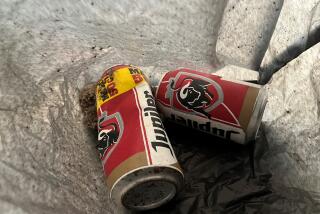‘Major Coup’ for L.A. County Museum
- Share via
In these days of high art prices and low acquisitions budgets, J. Patrice Marandel, the Los Angeles County Museum of Art’s curator of European painting and sculpture, is in an enviable position. Although the museum itself has little money to spend on artworks, the Ahmanson Foundation provides funds for acquisitions in his department. A couple of times each year, he adds something special to the collection.
Marandel has rarely been happier than he was Thursday afternoon, when the museum snagged “Plague in an Ancient City,” an ambitious history painting by 17th century Flemish artist Michael Sweerts, at a Sotheby’s New York auction. The purchase price, $3.85 million, was an auction record for the artist and the top sum paid in the $10.9-million sale of eight Old Master paintings from the collection of New York insurance mogul Saul Steinberg.
“It’s one of the great, great masterpieces of 17th century European painting, and Flemish painting in particular,” Marandel said in a telephone interview. “I’ve had tons of calls saying, ‘Congratulations.’ It’s a major coup for us.”
The 46 3/4-by-67 1/4-inch work depicts the effects of a devastating disease on an urban population. Groups of people congregate in a city square while others lie sick or dying, against a backdrop of ancient buildings and broken columns.
“It’s a very moving painting,” Marandel said. “It’s about death, but it’s also about hope and resurrection.”
Little is known of the painting’s early history, but it seems likely to have been commissioned because it is the only work of its kind by Sweerts, who generally painted portraits, genre scenes illustrating Christian virtues and views of artists’ lives.
The Sweerts is expected to arrive at the museum in a week or two, and go on view shortly thereafter. In a few months, after the public has had a chance to see it, the painting will be cleaned in the museum’s conservation laboratory.
Born in Brussels in 1618, Sweerts worked in Rome from 1643-56. LACMA’s new acquisition may have been based on an actual plague that raged through Rome during Sweerts’ sojourn there. But the scene is also steeped in tradition. “It seems to draw on [literary] descriptions of plague in antiquity and, visually, on interpretations of the plague by people like Raphael,” Marandel said.
*
For many years the painting was attributed to French artist Nicolas Poussin, whose interpretation of a similar subject, “Plague at Ashdod,” is at the Louvre in Paris. But in 1934 an Italian art historian determined that Sweerts painted “Plague in an Ancient City.”
“It is obviously not a Poussin,” Marandel said. “Poussin’s plague painting is fabulous, but it’s more intellectual and very Classic. This one is much more humanistic, and it’s rooted in the here and now.”
The Sweerts was in English family collections from the early 19th century until 1984, when Steinberg purchased it at auction for $1.2 million from the estate of Sir Herbert Cook.
At LACMA, it will join two other 17th century paintings by Flemish artists acquired with Ahmanson funds, but their subjects are single figures. Sir Anthony van Dyck’s “Andromeda Chained to a Rock” is based on Greek mythology, while Philippe de Champaigne’s “Saint Augustine” is religious image typical of the French Counter-Reformation.
Marandel equates the Sweerts to one of the museum’s most highly regarded Ahmanson gifts, “Magdalen With the Smoking Flame” by Georges de La Tour. “This may sound pretentious, but I think it is as important as the La Tour,” he said. “This painting is just as adventurous and forward-looking.”
In 1977, when the La Tour came to LACMA, the 17th century French master--whose work is the subject of a major traveling exhibition, opening Sunday at the Kimbell Art Museum in Fort Worth--was not nearly as well known as he is today. Sweerts, too, is far from a household name, but his plague scene is famous in art historical circles, Marandel said. “It’s nice once in awhile to be able to buy something that is in the literature and people know about. I think a lot of people will come to Los Angeles to see it because it is an important painting.”
More to Read
The biggest entertainment stories
Get our big stories about Hollywood, film, television, music, arts, culture and more right in your inbox as soon as they publish.
You may occasionally receive promotional content from the Los Angeles Times.










